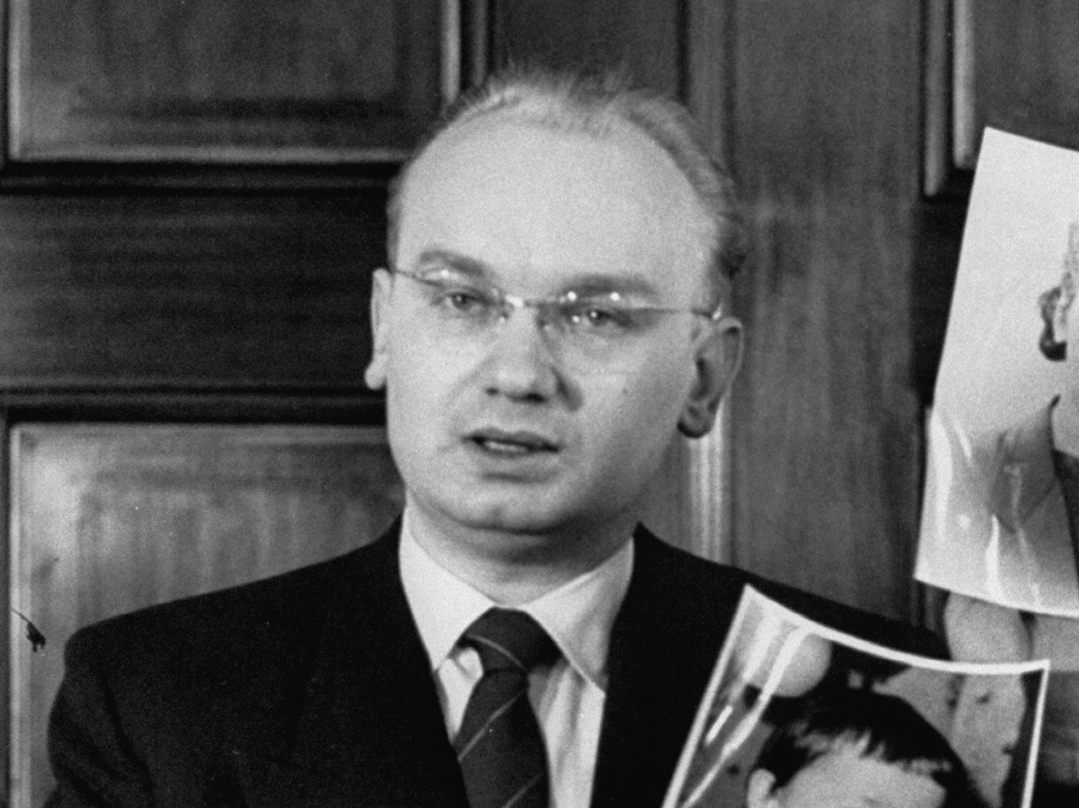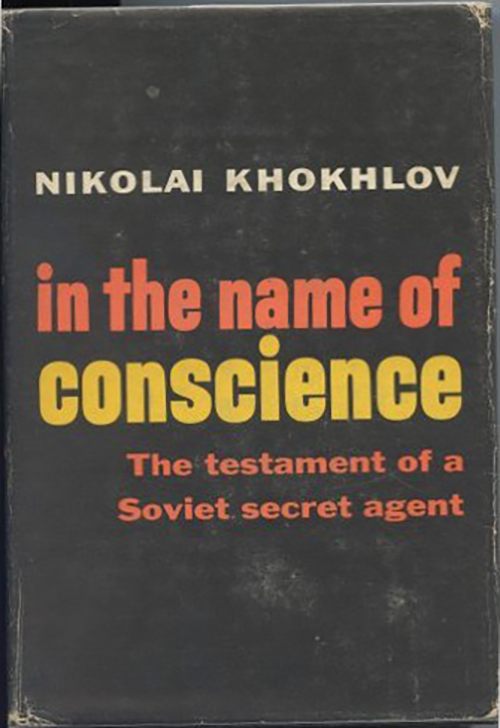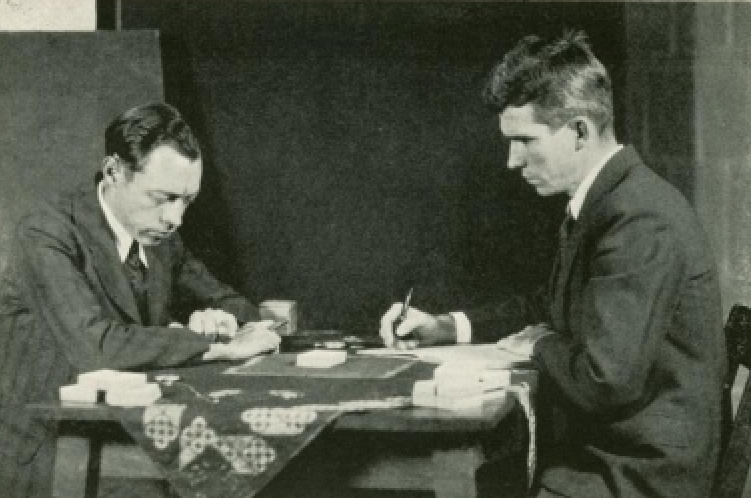The Russian Spy Who Convinced America to Take ESP Seriously
History’s spookiest spook.

On the afternoon of April 22, 1954, reporters massed at a press conference in Bonn, Germany. They’d been invited to meet one Nikolai Evgenievich Khokhlov, a captain in the Soviet Union’s newly minted security force, the KGB. Well, a former captain. Khokhlov had arrived in Germany tasked with assassinating the leader of an anticommunist organization. Instead he defected, tipping off the target and surrendering himself to U.S. agents. He was now no longer at the center of a murder plot, but a media event.
The 32-year-old Khokhlov was a “slight, scholarly-appearing blond young man. He was neatly dressed in a dark blue suit. He wore glasses,” reported The New York Times. The Times reporter observed that the defector was self-possessed and calm, “adroitly” fielding questions in Russian.
Though Khokhlov’s press conference came just weeks after another high-profile defection of a KGB official in Australia, his actions were thrilling enough to grab headlines. Even better, he had brought with him the exotic murder weapons constructed for the plot: two seemingly normal cigarette cases. “But they are ideal weapons for an assassin,” wrote the Associated Press at the time, “because of their innocent appearance, lightness and efficiency.” Flip the lid of the case back, and it revealed what appeared to be rows of run-of-the mill smokes. But press a concealed button, and a tiny four-inch-long pistol hidden inside would fire hollow-nosed bullets spiked with potassium cyanide. Upon being fired, the “resulting noise is no louder than the snap of the fingers and might pass unnoticed in the moderate conversation in a normal office,” wrote the AP.

Khokhlov later testified before the U.S. Congress about Soviet intelligence activities and became something of a media star. His story inspired a four-part series in the Saturday Evening Post called “I Would Not Murder for the Soviets,” and in 1957 he published a memoir, In the Name of Conscience. That was also the same year the KGB made an attempt on his life. After giving a speech in Frankfurt, Khokhlov had been served a cup of coffee, which he wrote in his memoir “did not seem to me as good as usual.” Soon he felt tired, and a “strange weight oppressed” his heart and stomach. Khokhlov collapsed in a parking lot. He had been dosed with thallium, a slow-acting poison that causes considerable pain before killing its victim. Khokhlov was lucky, though, and ultimately recovered after weeks in the hospital. His poisoning had coincided with the successful launch of Sputnik, and he reflected upon this in his book. “I, too, was an exhibit of the achievements of Soviet science,” he wrote. “Totally bald, so disfigured by scars and spots that those who had known me did not at first recognize me, confined to a rigid diet, I was nevertheless also living proof that Soviet science, the science of killing, is not omnipotent.”
Having defected from the KGB, survived a poisoning attempt, and spent years in the media spotlight, it might be natural to assume Khokhlov was ready for some peace and quiet. And he did eventually fall into the life of an academic, beginning studies at Duke University in the 1960s. But in the end, it’s clear Khokhlov was never meant to lead an ordinary life.
While studying psychology at Duke, Khokhlov found himself in the orbit of one of the university’s most eclectic personalities, Joseph Banks Rhine, or J.B. Rhine. Rhine was a botanist from Pennsylvania who went on to study psychology at Harvard and became fascinated by what he called “extra-sensory perception”—the idea that the human mind had powers beyond the known senses. He studied clairvoyance, ESP, and telepathy, and eventually founded the Institute for Parapsychology at Duke. The lab (which still exists today as the independent Rhine Research Center) has the distinction of inspiring the scene in Ghostbusters where Bill Murray’s Peter Venkman tests his students’ clairvoyant capacities with a deck of marked cards. (In a weird coincidence, the assassination plot that sparked Khokhlov’s defection was called Operation Rhine.)
It was under Rhine’s tutelage that Khokhlov’s interest in the paranormal flourished, and it was also how he found himself at the Institute for Parapsychology on September 1, 1966, presenting a paper called “The Relationship of Parapsychology to Communism.” A number of paranormal researchers had assembled at the institute, whose base was a stately white house with a porch and balcony.

“In Soviet Russia considerable interest has been aroused in research in parapsychology,” Khokhlov began. Russian character, Khokhlov told the Institute’s attentive dinner guests, made for a people “specifically sensitive to matters relative to the mystical side of the human psyche” and “to a world beyond the sober reality of sense.” He then lectured the group about Russian scientists who had undertaken studies of ESP dating back to the late 1800s. He told them that the Soviet government actively encouraged such study, and name-checked prominent Russians (from astrophysicists to philosophers) who supported parapsychological inquiry. He described studies in which subjects had been able to perceive images from over a distance of nearly 2,000 miles. He concluded his talk on a hopeful note, saying, “The fate of the world today depends on the common understanding by the whole human race of what a human being really is. Here we are, on this side of the Iron Curtain, a small group of parapsychologists, trying to enlarge the common notion of man. And there are they, men of science and spirit, who are striving for the same higher goal.”
Rhine published the paper in a book, Parapsychology Today, and offered the ex-KGB officer a position on his staff once he had earned his doctorate. But Khokhlov declined. He later wrote in an email to the author Stacy Horn, who chronicled the goings-on at the Institute in her book Unbelievable, that he had lost faith in Rhine’s propensity for “pure statistical manipulations without touching the inevitable issue of human consciousness and its metaphysical essence.”
Khokhlov eventually went west, to California, hotbed of all things metaphysical. He became a professor at California State University, San Bernardino, where he continued to study parapsychology. There he hosted talks on psychic phenomena (“If you think you’re a psychic, or just interested, come and feel the vibes next Tuesday,” read a notice for one of his workshops in the school newspaper.) He taught courses in experimental hypnosis, and delivered lectures on spiritual life. He gave interviews on parapsychology and on his KGB years to David Brinkley and 60 Minutes. The U.S. government even tapped him to study parapsychology in the Soviet Union on its behalf.
Khokhlov became a U.S. citizen in 1970. In 1992, Russian President Boris Yeltsin pardoned him.
Over the years, his interests expanded beyond parapsychology. He learned computer programming and dedicated himself to environmentalism, eventually launching a “computerized carpool” that matched students with others nearby so they could commute to school together.
In 2007, the man who had fled Soviet Russia and survived a poisoning succumbed to a heart attack at 84. His papers, including his work on parapsychology, reside at the Hoover Institute, a think tank at Stanford University.
In Khokhlov’s writing, it’s easy to see a direct line between his abhorrence of the Soviet system and his attraction to the ethereal promises of the paranormal.
“Nothing can arrest the disintegration of inhuman rule,” wrote Khokhlov in his 1957 memoir. “The very qualities that communism has attempted to read out of existence—conscience, honor, loyalty to God’s commandments—are making for its collapse. In the final analysis, these elements will prove stronger than the rational ‘material’ forces.”









Follow us on Twitter to get the latest on the world's hidden wonders.
Like us on Facebook to get the latest on the world's hidden wonders.
Follow us on Twitter Like us on Facebook